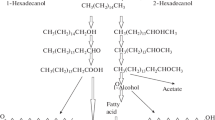Abstract
The roles of the extracellular biosurfactants produced by two bacterial strains, Pseudomonas aeruginosa GL1 and Rhodococcus equi Ou2, in hexadecane uptake and biodegradation were compared. For this purpose, cell hydrophobicity and production of glycolipidic biosurfactants were evaluated during bacterial growth on hexadecane, as well the effects of these biosurfactants on culture supernatants properties i.e., surface and interfacial tensions, and emulsification and pseudosolubilization capacities. The results showed that the role of biosurfactants was different in these two strains and was directly related to the hydrophobicity of the bacterial cells concerned. Extracellular biosurfactants produced by strain R. equi Ou2 had only a minor role in hexadecane degradation. Direct interfacial accession appeared to be the main mechanism for hexadecane uptake by the hydrophobic cells of strain R. equi Ou2. On the contrary, the biosurfactants produced by P. aeruginosa GL1 were required for growth on hexadecane, and their pseudosolubilization capacity rather than their emulsification capacity was involved in substrate degradation, allowing uptake from hexadecane micelles by the hydrophilic cells of this bacterium. The roles of biosurfactants thus differ widely among bacteria degrading hydrophobic compounds.



Similar content being viewed by others
References
Abalos A, Vinas M, Sabate J, Manresa MA, Solanas AM (2004) Enhanced biodegradation of Casablanca crude oil by a microbial consortium in presence of a rhamnolipid produced by Pseudomonas aeruginosa AT10. Biodegradation 15:249–260
Al-Tahhan RA, Sandrin TR, Bodour AA, Maier RM (2000) Rhamnolipid-induced removal of lipopolysaccharide from Pseudomonas aeruginosa: effect on cell surface properties and interaction with hydrophobic substrates. Appl Environ Microbiol 66:3262–3268
Arino S, Marchal R, Vandecasteele JP (1996) Identification and production of rhamnolipidic biosurfactants by a Pseudomonas species. Appl Microbiol Biotechnol 45:162–168
Bouchez-Naïtali M, Rakatozafy H, Marchal R, Leveau JY, Vandecasteele JP (1999) Diversity of bacterial strains degrading hexadecane in relation to the mode of substrate uptake. J Appl Microbiol 86:421–428
Bouchez-Naïtali M, Blanchet D, Bardin V, Vandecasteele JP (2001) Evidence for interfacial uptake in hexadecane degradation by Rhodococcus equi: the importance of cell flocculation. Microbiology 147:2537–2543
Dubois M, Gilles KA, Hamilton JK, Rebers PA, Smith T (1956) Colorimetric method for determination of sugars and related substances. Anal Chem 28:350–356
Goswami P, Singh HD (1991) Different modes of hydrocarbon uptake by two Pseudomonas species. Biotechnol Bioeng 37:1–11
Haferburg D, Hommel RK, Claus R et al (1986) Extracellular microbial lipids as biosurfactants. Adv Biochem Eng Biotechnol 33:53–93
Hommel RK (1994) Formation and function of biosurfactants for degradation of water-insoluble substrates. In: Ratledge C (ed) Biochemistry of microbial degradation. Kluwer Academic Publishers, Dordrecht
Hori K, Matsuzaki Y, Tanji Y, Unno H (2002) Effect of dispersing oil phase on the biodegradability of a solid alkane dissolved in non-biodegradable oil. Appl Microbiol Biotechnol 59:574–579
Hua Z, Chen J, Lun S, Wang X (2003) Influence of biosurfactants produced by Candida antartica on surface properties of microorganism and biodegradation of n-alkanes. Water Res 37:4143–4150
Husain DR, Goutx M, Acquaviva M, Gilewicz M, Bertrand JC (1997) The effect of temperature on eicosane substrate uptake modes by a marine bacterium Pseudomonas nautica strain 617: relationship with the biochemical content of cells and supernatants. World J Microbiol Biotechnol 13:587–590
Inakollu S, Hung HC, Shreve GS (2004) Biosurfactant enhancement of microbial degradation of various structural classes of hydrocarbon in mixed waste systems. Environ Eng Sci 21:463–469
Lang S, Philp JC (1998) Surface active lipids in rhodococci. Antonie Van Leeuwenhoek 74:59–70
Lee M, Kim MK, Singleton I, Goodfellow M, Lee ST (2006) Enhanced biodegradation of diesel oil by a newly identified Rhodococcus baikonurensis EN3 in the presence of mycolic acid. J Appl Microbiol 100:325–333
Mulligan CN (2005) Environmental applications for biosurfactants. Environ pollut 133:183–198
Neu TR, Poralla K (1990) Emulsifying agents from bacteria isolating during screening for cells with hydrophobic surfaces. Appl Microbiol Biotechnol 32:521–525
Noordman WH, Janssen DB (2002) Rhamnolipid stimulates uptake of hydrophobic compounds by Pseudomonas aeruginosa. Appl Environ Microbiol 68:4502–4508
Prabhu Y, Phale PS (2003) Biodegradation of phenanthrene by Pseudomonas sp. strain PP2: novel metabolic pathway, role of biosurfactant and cell surface hydrophobicity in hydrocarbon assimilation. Appl Microbiol Biotechnol 61:342–351
Pruthi V, Cameotra SS (1997) Rapid identification of biosurfactant-producing strains using a cell surface hydrophobicity technique. Biotechnol Tech 11:671–674
Puntus IF, Sakharovsky V, Filonov AE, Boronin AM (2005) Surface activity and metabolism of hydrocarbon-degrading microorganisms growing on hexadecane and naphthalene. Process Biochem 40:2643–2648
Reddy PG, Singh HD, Pathak MG, Bhagat SD, Baruah JN (1983) Isolation and functional characterization of hydrocarbon emulsifying and solubilizing factors produced by a Pseudomonas species. Biotechnol Bioeng 25:387–401
Rosenberg M (1984) Bacterial adherence to hydrocarbons: a useful technique for studying cell surface hydrophobicity. FEMS Microbiol Lett 22:289–295
Singh A, Van Hamme JD, Ward OP (2007) Surfactants in microbiology and biotechnology: part 2. Application aspects. Biotechnol Adv 25:99–121
Song RH, Hua ZZ, Li HZ, Chen J (2006) Biodegradation of petroleum hydrocarbons by two Pseudomonas aeruginosa strains with different uptake modes. J Environ Sci Health A 41:733–748
Van Hamme JD, Singh A, Ward OP (2006) Physiological aspects—part 1 in a series of papers devoted to surfactants in microbiology and biotechnology. Biotechnol Adv 24:604–620
Acknowledgements
The authors thank Hazem Bouzrara and Maria Autran for their collaboration in the experimental work. They also thank Daniel Ballerini for having access to the tensiometer equipment at Institut Français du Pétrole (Rueil Malmaison, France).
Author information
Authors and Affiliations
Corresponding author
Additional information
J.-P. Vandecasteele—in retirement
Rights and permissions
About this article
Cite this article
Bouchez-Naïtali, M., Vandecasteele, JP. Biosurfactants, an help in the biodegradation of hexadecane? The case of Rhodococcus and Pseudomonas strains. World J Microbiol Biotechnol 24, 1901–1907 (2008). https://doi.org/10.1007/s11274-008-9691-9
Received:
Accepted:
Published:
Issue Date:
DOI: https://doi.org/10.1007/s11274-008-9691-9




